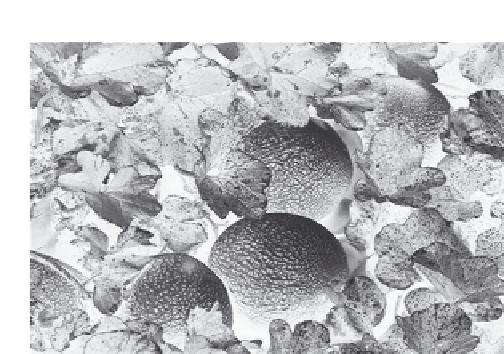Agriculture Reference
In-Depth Information
Phosphorus deficiency in European seedless cucumbers
caused cell membranes to become more permeable,
increasing electrolyte leakage and inducing a stress-related
burst in respiration, reducing post-harvest life (Knowles
et al
. 2001).
The shift from water-intensive furrow irrigation to
nutrient solution applied via drip irrigation had no negative
effects on cantaloupe yield or quality in California (Hartz
1997). 'Galia'-type melons were successfully grown using
saline irrigation water, with no significant effects in fruit
quality and yield (Mendlinger & Pasternak 1992). Pre-
harvest application of AVG (aminoethoxyvinylglycine, an
ethylene synthesis inhibitor) on cantaloupe slightly delayed
initial development of the abscission zone and caused leaf
chlorosis, but did not affect fruit quality at harvest or fol-
lowing storage. During storage AVG-treated fruits had
decreased ethylene production up to 30% over control fruit
without an effect on quality (Shellie 1999).
Feeding of the silverleaf whitefly (
Bemisia argentifolii
)
on squash leaves induces leaf silvering and fruit colour
blanching, significantly reducing marketability (Maynard &
Cantliffe 1989). Instead of typical medium to dark green
colouration, zucchini fruit appear light green, whereas
acorn squash are mottled green and/or yellow; golden
acorn squash are white. Although all squash types are sus-
ceptible to whitefly feeding, symptoms have not been
observed on cucumber, watermelon or cantaloupe fruits.
Figure 14.13
Clay applied to developing fruits can
reduce solar injury.
20 to30 centimetres in length (Figure 14.14b). Wehner
(1996) also reported that cucurbits can develop bitter
flavour when drought stressed during fruit development, a
consequence of high cucurbitacin content. Breeding pro-
grams have developed cultivars with low cucurbitacin con-
tent; however, cross-pollination of these cultivars with high
cucubitacin types can induce bitterness.
Light intensity and spectral quality have been correlated
to fruit quality of European seedless cucumbers grown in
greenhouses, particularly as encountered in northern cli-
mates during winter months. Poor light quality signifi-
cantly reduces post-harvest quality by limiting chlorophyll
synthesis, thereby hastening the onset of yellowing and
reducing post-harvest life (Lin & Jolliffe 1996).
Cucurbits are susceptible to chilling injury, a physiologi-
cal disorder that occurs when the crop is exposed to tem-
peratures below the safe storage temperature and above
freezing. It can occur in the field, but most commonly
occurs during handling and shipping. Chilling injury is time
and temperature related and is caused by a disruption in nor-
mal functions in cell membranes leading to localized necro-
sis. Once the integrity of the tissue is compromised, infection
readily takes place by saprophytic microorganisms. External
symptoms of chilling injury in cucurbits include the appear-
ance of water-soaked or sunken areas on cucumber and
cantaloupe, pitting on watermelon (Plate 14.2a), (Snowden
1992), and bronzing of the epidermis of 'Galia'-type melons
(Plate 14.2b) (Pacheco 1996) and honeydew (Plate 14.2c).
Chilling injury occurred in cucumber after 7 days storage at
4°C (Hariyadi & Parkin, 1991), and after 7 days storage
at 7.5°C in Beit Alpha cucumbers (Stapleton
et al
. 2002)
(Plate 14.2d). 'Dixie'yellow crookneck summer squash
Temperature stress
Excessive field exposure to sunlight due to poor foliage
coverage can lead to development of heat injury symp-
toms. Prolonged high temperatures in the exposed tissues
disrupt normal ripening, resulting in off-colours and off-
flavour/aroma in epidermal and mesocarp tissues. Sub-
epidermal pulp temperatures of honeydew melons exposed
to direct sunlight reached as high as 48°C in tests in
California, leading to solar yellowing ('sunburn') (Lipton
et al
. 1987). Protective coatings of clay-based materials
assist in circumventing this problem (Figure 14.13). Yellow
pigment synthesis was reported for honeydew melons
exposed to high amounts of solar radiation (Forney 1990).
Hot, dry weather discourages foraging by pollinating
insects and desiccates flowers, reducing pollination in
field-grown squash and cucumbers resulting in misshapen
fruits (Wehner 1996) (Figure 14.14a). These conditions
can also cause the development of internal void spaces
during the fruit growth phase, eventually appearing as soft,
sunken areas under the epidermis that can be easily
mistaken for bruising. However, upon slicing, the underly-
ing voids may be several millimetres in diameter and






























